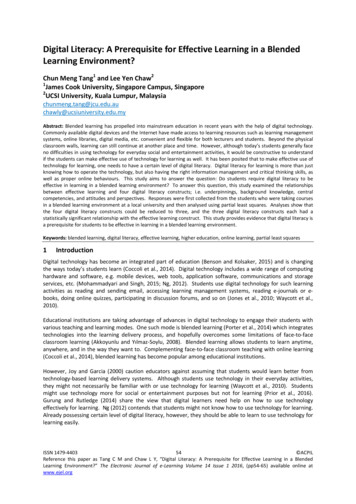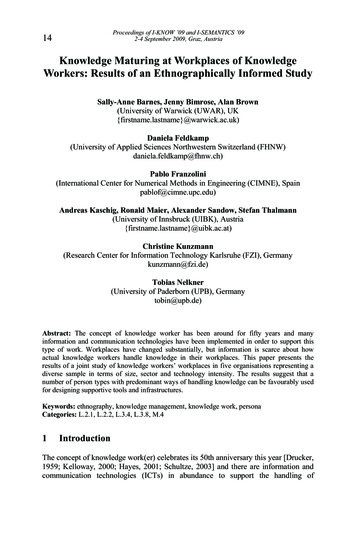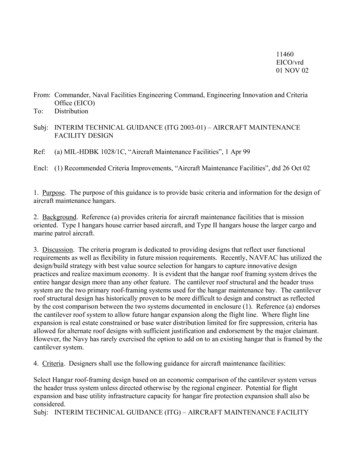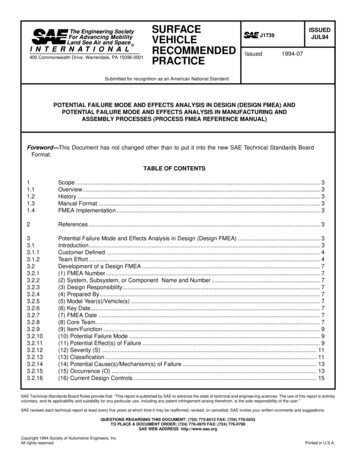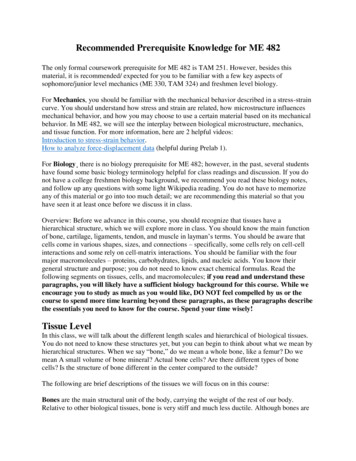
Transcription
Recommended Prerequisite Knowledge for ME 482The only formal coursework prerequisite for ME 482 is TAM 251. However, besides thismaterial, it is recommended/ expected for you to be familiar with a few key aspects ofsophomore/junior level mechanics (ME 330, TAM 324) and freshmen level biology.For Mechanics, you should be familiar with the mechanical behavior described in a stress-straincurve. You should understand how stress and strain are related, how microstructure influencesmechanical behavior, and how you may choose to use a certain material based on its mechanicalbehavior. In ME 482, we will see the interplay between biological microstructure, mechanics,and tissue function. For more information, here are 2 helpful videos:Introduction to stress-strain behavior.How to analyze force-displacement data (helpful during Prelab 1).For Biology there is no biology prerequisite for ME 482; however, in the past, several studentshave found some basic biology terminology helpful for class readings and discussion. If you donot have a college freshmen biology background, we recommend you read these biology notes,and follow up any questions with some light Wikipedia reading. You do not have to memorizeany of this material or go into too much detail; we are recommending this material so that youhave seen it at least once before we discuss it in class.Overview: Before we advance in this course, you should recognize that tissues have ahierarchical structure, which we will explore more in class. You should know the main functionof bone, cartilage, ligaments, tendon, and muscle in layman’s terms. You should be aware thatcells come in various shapes, sizes, and connections – specifically, some cells rely on cell-cellinteractions and some rely on cell-matrix interactions. You should be familiar with the fourmajor macromolecules – proteins, carbohydrates, lipids, and nucleic acids. You know theirgeneral structure and purpose; you do not need to know exact chemical formulas. Read thefollowing segments on tissues, cells, and macromolecules; if you read and understand theseparagraphs, you will likely have a sufficient biology background for this course. While weencourage you to study as much as you would like, DO NOT feel compelled by us or thecourse to spend more time learning beyond these paragraphs, as these paragraphs describethe essentials you need to know for the course. Spend your time wisely!Tissue LevelIn this class, we will talk about the different length scales and hierarchical of biological tissues.You do not need to know these structures yet, but you can begin to think about what we mean byhierarchical structures. When we say “bone,” do we mean a whole bone, like a femur? Do wemean A small volume of bone mineral? Actual bone cells? Are there different types of bonecells? Is the structure of bone different in the center compared to the outside?The following are brief descriptions of the tissues we will focus on in this course:Bones are the main structural unit of the body, carrying the weight of the rest of our body.Relative to other biological tissues, bone is very stiff and much less ductile. Although bones are
mainly loaded in compression, they are capable of tensile, bending, and torsional loads, albeit toa lesser extent. Some bones are more load-bearing than others (think legs vs arms, bipedal vsquadrupedal creatures); how might the loading change the structure of bone?There are three types of Cartilage: elastic cartilage (more flexible, cartilage in outer ear), hyalinecartilage (covers joints and bones), and fibrocartilage (in joints, at the bone-tendon interface).Cartilage is less stiff than bone, but stiffer than other tissues; it is more ductile than bone. Thiscourse will focus on articular cartilage, a subset of hyaline cartilage that covers the surface ofbone.Ligaments connect bone to bone. Tendons connect bone to muscle. These two tissues havesimilar structures and primarily loaded in tension. What might be different between bone-to-boneconnections than muscle-to-bone connections?There are skeletal, smooth, and cardiac muscles. We do not spend much time on muscle, but ifwe do, we will focus on skeletal muscles. Skeletal Muscles generate force in tension. Musclefibers are all aligned parallel to each other, so they are strong in one direction.Cellular LevelWe will not discuss cellular or subcellular structures in much detail in this course. You shouldknow that in some tissues, cells are tightly packed together and have many cell-cell interactions(e.g. epithelial cells, like skin, in the figure below), and other cells are more isolated, exist in theextracellular matrix (ECM), and have cell-ECM interactions (e.g. adipose, bone cells in thefigure below), and some cells are suspended (e.g. blood cells in the figure below). You do notneed to know about these connections or cell types – we will discuss the important ones in class.We are just pointing out that cells come in various shapes and sizes. Some cells are only a fewmicrons, and some, like neurons, can be meters long to connect your brain to your lower limbs.
It might be helpful to be familiar with the common features of a cell, like the nucleus, cytoplasm,mitochondria, and cell membrane, in case they come up in readings, but these will not be thefocus of the course.Major MacromoleculesProteinsProteins are responsible for most cellular functions. For us, proteins may function as a structuralelement (e.g. collagen and elastin providing structure in the ECM), a catalyst for reactions(enzymes), or a signal relay (send/receive signals from a cell to another cell, from a cell to theECM, or from the ECM to the cell).Proteins are made up of Amino Acids. An Amino Acid has the general structure of an aminogroup, a carbon, carboxyl group, and an R group (also called the side chain).
There are 20 different amino acids, eacg with a different R group. The R groups are commonlyclassified as being positively/negatively charged or uncharged, hydrophobic/hydrophilic(nonpolar/polar), and small/large in size. The amino acids bind as shown below to create aprotein. Proteins can be several to several thousands of amino acids in length; the average proteinis about 200 amino acids in length.The arrangement of the amino acids determine the protein shape and function. Proteins that gothrough a lipid membrane (transmembrane proteins), will have different hydrophobic andhydrophilic domains that interact with the different hydrophobic and hydrophilic domains of thelipid membrane.Lipids (fats)Lipids make up membranes in the cell. Some membranes, like the cell membrane, are a bilayer,and some are a single-layer. Lipids consist of a hydrophilic head (white in the diagram below)and a hydrophobic tail (yellow).
Carbohydrates (Saccharides)For this course, you should know that carbohydrates are one of the major macromolecules, andgenerally have the formula Cm(H2O)n, where m and n are integers.Nucleic Acids (DNA and RNA)DNA (deoxyribonucleic acid) and RNA (ribonucleic acid) We will not talk about DNA and RNAtoo much in this course.You may want to be briefly familiar with the Central Dogma of Biology. In short, in replication,DNA copies itself for more DNA; in transcription, DNA makes RNA; and in translation, thisRNA makes proteins.
Complex MacromoleculesThese macromolecules work together for various functions. For example, there are manytransmembrane proteins in the cell lipid bilayer membrane to connect to the extracellular matrixor transport molecules into/out of the cell. Proteoglycans are a negatively-charged protein andcarbohydrate molecule that helps resist compressive loads. From the figure below, how does thenegative charge resist compressive loads?Source: Altered swelling and ion fluxes in articular cartilage as a biomarker in osteoarthritis andjoint immobilization: a computational analysis. Sara Manzano, Raquel Manzano, ManuelDoblaré, Mohamed Hamdy Doweidar. J. R. Soc. Interface 2015 12 20141090; DOI:10.1098/rsif.2014.1090. Published 12 November 2014
The only formal coursework prerequisite for ME 482 is TAM 251. However, besides this material, it is recommended/ expected for you to be familiar with a few key aspects of sophomore/junior level mechanics (ME 330, TAM 324) and freshmen level biology. For Mechanics, you should be familiar with the mechanical behavior described in a stress-strain
